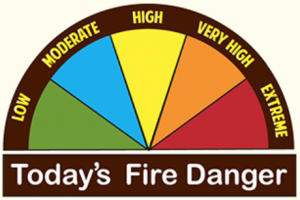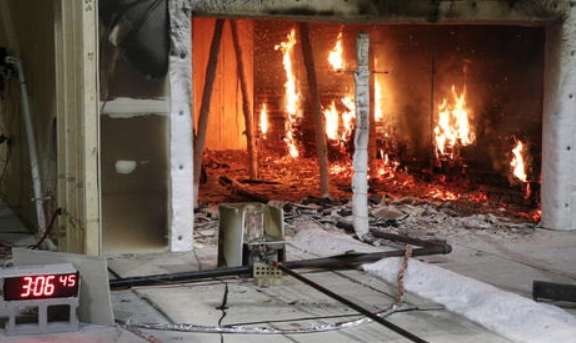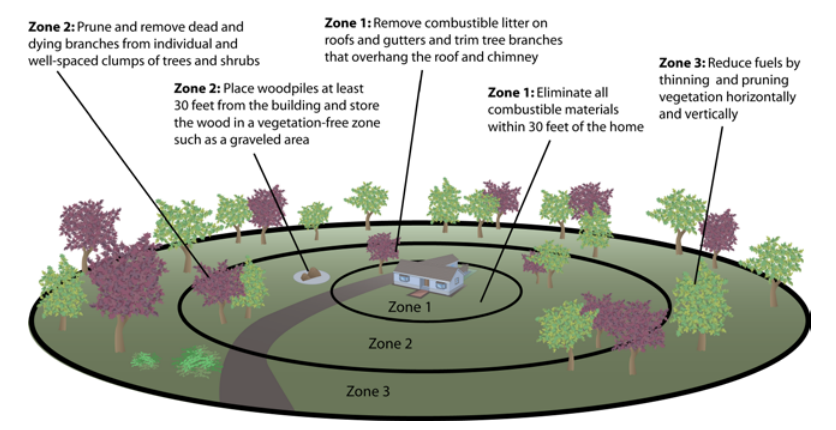
Fire Proof Building
The past few summers I’ve been caught somewhat off guard by how vulnerable I feel when dry winds are blowing and smoke fills the sky. I remember very clearly being on the roof, with a mask on, cleaning out gutters and small piles of leaves. As an industrial hygienist, I know harm of dust and smoke from wildfires, but when the time came to protect my home I felt overwhelmed and unprepared. I remember looking around our valley and seeing tightly packed homes in the foreground with golden brown, grassy hills in the background. Trying to clean ash off my solar panels I caught myself thinking, “I wish I could enjoy a fire proof building.”

Can a Building be Fire Proof?
The short answer is no. At some point a fire is hot enough to melt steel and destroy concrete, and even before concrete is destroyed all contents within a building would be destroyed. So technically I suppose you cannot have a “fire proof” building. When a hundred structures are burning within feet of each other and the wind is howling in your direction, the only way to survive is to evacuate because the fire is too intense for any typically constructed building. However, experts now use the term “fire hardened,” and everyone agrees that you can significantly reduce the risk of catastrophic fire by following some simple recommendations. Just as I can look at a building and point out weak spots in moisture management and things that are likely to cause long term water damage or mold growth, a fire expert can similarly evaluate a building for fire risk. This obviously piqued my interest and now I’m happy to share these concepts with you.
Disclaimer: You cannot have a fire proof building. These concepts are borrowed from other sources and in no way should substitute for having a professional assessment, and engaging licensed design and construction professionals to harden your building. Finally, just reading this won’t do anything to reduce your risk. Get out there and make some improvements.
 How Do Fires Start and Spread?
How Do Fires Start and Spread?
In order to understand the why of fire hardening, one must first understand how fires start and spread. Remember the fire pyramid?
Fires need fuel, oxygen and heat. (period) If you eliminate any of these variables – you will extinguish a fire. Thinking preemptively, if you reduce any of these variables in a given area you reduce the risk of fire occurring.
Examples include:
- Fuel – Gases (e.g., propane, oxygen, etc.), liquids (e.g., gasoline, alcohol, etc.) and solids (e.g., leaves, trees, fences, decks, wooden siding, etc.) provide fuel for fires. Eliminating or protecting these fuels from fire is the most obvious means of fire hardening.
- Oxygen – Many fire suppression systems, such as fire extinguishers or helicopters dropping flame retardant foams, operate by removing oxygen from an active fire. Shoveling dirt over a camp fire is an example of suffocating a fire.
- Heat – Combustion requires an initial heat source. Ignition may start from a chemical reaction, lightning, electrical sparks, cigarette butts or a random ember flying from an unprotected chimney. Cooling materials will slow a fire, and if you remove enough heat fast enough, it will extinguish a fire.
Recent catastrophic fires in California have occurred in a perfect storm. Trees (fuel) have grown too close to power lines and eventually a spark (heat) starts a fire. Dry winds blow the fire across crispy fields and through forests full of dense undergrowth and standing dead trees. Intense fires create their own weather patterns with massive uplifts of wind which lift and carry embers far ahead of the actual blaze. Those embers ignite smaller fires ahead of the main fire, and by the time the main fire meets the smaller fire it’s a raging storm of heat and destruction. In some instances embers from wildfires have started fires up to a mile away from the big fire. Once in an urban setting fires jump rapidly from building to building, and embers fly into buildings and land in cluttered gutters and on dry wooden decks. The hot, dry wind distributes embers but also increases temperatures and desiccates materials so when ignition occurs it’s instant and the fire spreads very quickly.
Any building in the midst of a fire storm is unlikely to survive, but there are many things we can do to reduce the risk of fire in the more common “small fire” incidents to which we are accustomed. In every major fire the initial ignition source starts small. Taking these steps not only fire hardens your building, but takes steps toward reducing risk for your entire community.

Practical Fire Hardening Tips:
Here are tips from Ready For Wildfire to harden your building and make it more fire resistant:
- Roof
- The roof is the most vulnerable part of your building. Buildings with wood or shingle roofs are at high risk of being destroyed during a wildfire. Build your roof or re-roof with materials such as composition, metal or tile. Block any spaces between roof decking and covering to prevent embers from catching.
- Vents
- Vents on buildings create openings for flying embers.
- Cover all vent openings with 1/8-inch metal mesh. Do not use fiberglass or plastic mesh because they can melt and burn.
- Protect vents in eaves or cornices with baffles to block embers (mesh is not enough).
- Eaves and Soffits
- Eaves and soffits should be protected with ignition resistant* or noncombustible materials.
- Windows
- Heat from a wildfire can cause windows to break even before the building ignites. This allows burning embers to enter and start fires inside. Single-pane and larger windows are particularly vulnerable.
- Install dual-pane windows with one pane of tempered glass to reduce the chance of breakage in a fire.
- Consider limiting the size and number of windows that face large areas of vegetation.
- Walls
- Wood products, such as boards, panels or shingles, are common siding materials. However, they are combustible and not good choices for fire prone areas.
- Build or remodel your walls with ignition resistant* building materials, such as stucco, fiber cement, wall siding, fire retardant, treated wood, or other approved materials.
- Be sure to extend materials from the foundation to the roof.
- Decks
- Surfaces within 10 feet of the building should be built with ignition resistant*, noncombustible, or other approved materials.
- Ensure that all combustible items are removed from beneath your deck.
- Rain Gutters
- Screen or enclose rain gutters to prevent accumulation of plant debris.
- Patio Cover
- Use the same ignition resistant* materials for patio coverings as a roof.
- *Ignition resistant building materials are those that resist ignition or sustained burning when exposed to embers and small flames from wildfires. Examples of ignition resistant materials include “noncombustible materials” that don’t burn, exterior grade fire-retardant treated wood lumber, fire-retardant treated wood shakes and shingles listed by the State Fire Marshal (SFM) and any material that has been tested in accordance with SFM Standard 12-7A-5.
- Chimney
- Cover your chimney and stovepipe outlets with a noncombustible screen. Use metal screen material with openings no smaller than 3/8-inch and no larger than 1/2-inch to prevent embers from escaping and igniting a fire.
- Garage
- Have a fire extinguisher and tools such as a shovel, rake, bucket, and hoe available for fire emergencies.
- Install weather stripping around and under the garage door to prevent embers from blowing in.
- Store all combustible and flammable liquids away from ignition sources.
- Fences
- Consider using ignition resistant* or noncombustible fence materials to protect your building during a wildfire.
- Driveways and Access Roads
- Driveways should be built and maintained in accordance with state and local codes to allow fire and emergency vehicles to reach your building. Consider maintaining access roads with a minimum of 10 feet of clearance on either side, allowing for two-way traffic.
- Ensure that all gates open inward and are wide enough to accommodate emergency equipment.
- Trim trees and shrubs overhanging the road to allow emergency vehicles to pass.
- Address
- Make sure your address is clearly visible from the road.
- Water Supply
- Consider having multiple garden hoses that are long enough to reach all areas of your building and other structures on your property. If you have a pool or well, consider getting a pump.
Creating Defensible Space

- Zone 1
- Eliminate all combustible materials in Zone 1 (within 30 feet of the home) such as fire-prone vegetation, firewood stacks, combustible patio furniture, umbrellas, and dimensional lumber decking. Desirable substitutions include irrigated grass, rock gardens, stone patios, metal patio furniture, and noncombustible decking.
- Before fire season begins, remove combustible litter on roofs and gutters and trim tree branches that overhang the roof and chimney.
- Zone 2
- Ensure that Zone 2 includes only individual and well spaced clumps of trees and shrubs and/or a few islands of vegetation surrounded by areas with noncombustible materials.
- Use hardscape features such as driveways and paved or gravel walkways or patios to create firebreaks throughout the yard.
- Plant fire resistant, low volume vegetation that retains moisture well and needs minimum maintenance such as pruning and removing dead and dying branches.
- Separate auxiliary structures such as a detached garage, pump house, pergola, and utility shed from the home by at least 50 feet. Increase the distance if the structure is used for the storage of combustible materials.
- Comply with recommended construction practices related to fire resistance for auxiliary structures.
- Ensure that patio furniture is either made of noncombustible material such as metal or is at least 30 feet away from the building. Store patio furniture in a location that is protected from ignition by a wildfire.
- Place woodpiles at least 30 feet from the building and store the wood in a vegetation free zone such as a graveled area.
- Store fuel tanks away from a structure at the minimum distance that is required by code or greater and place underground or on a noncombustible pad.
- Zone 3
- Reduce fuels that are farther than 100 feet from the building by thinning and pruning vegetation horizontally and vertically as discussed above. Thinning and pruning in Zone 3 can be more limited than in Zone 2. The goals in Zone 3 are to improve the health of the wild lands and help slow an approaching wildfire. Zone 3 is also an aesthetic transition between the more heavily modified Zone 2 and the unmodified surroundings.





Actually… I believe the research shows that vents have been the most common source of starting house fires when exposed to embers outside. And if you read the whole post I think you’ll see that we don’t believe a building can ever really be “fire proof.”
It was really informative when you mentioned that the roof of a building is the most vulnerable part. When you are trying to fireproof a building, I would imagine that it would be a good idea to work with a business that specializes in protection. This kind of business will know to construct a building that is fireproof.